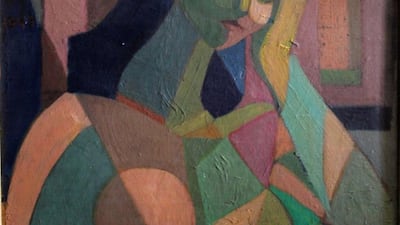Artistic expression is so often defined in terms of its medium: a painting, a poem, a play. In turn, artists are defined by the medium they most often employ. When considering Ahmed Morsi, an artist born in Alexandria in 1930, it quickly becomes clear that one must resist the temptation to define him in this one dimensional way. Rather, one is compelled to examine Morsi’s entire creative oeuvre, for which painting is the constant lifeblood, while poetry, art criticism, literary criticism, set design, lithography, artist books and photography are all veins that flow through his creative biography.
The retrospective exhibition at the Sharjah Art Museum, Ahmed Morsi: A Dialogic Imagination, fittingly pays homage to the many facets of Morsi's artistic expressions, with its robust collection that carries the visitor through his early work in the 1950s all the way through the present day. The exhibition draws the visitor in with a quotation from Samir Gharib observing that: "Ahmed Morsi paints his poetry and writes his paintings."
If we are to take that quotation literally, the paintings lining the two long galleries can be read almost as Morsi's complete works. As a fellow museum-goer observed to me, "It's as if he's created his own private language of symbols." The experience thus becomes, in part, a semiotic exercise as one reads the evolving interplay between man, woman, and beast (primarily dogs, birds, fish, and horses), bearing predominant and sometimes cyclopoid eyes, mask-like faces of sombre expression, with the occasional fissure running through his depictions of women like an ancient cracked vase. Several of the paintings from the 90s incorporate headless mannequins and grandfather clocks, which, when viewed through Morsi's melancholic hues, conjured for me the early paintings of Giorgio de Chirico, whose scuola metafisica influenced the Surrealists' use of space and symbolism. Taken as a whole, the work invoked a disembodied nostalgia for something I could not pinpoint, almost as if it was directed toward a time in history that lies between the self and a sense of collective history.
If Morsi’s paintings pleasantly tickle one’s sense of melancholia, his poems bring that elusive emotion into focus, describing faded Polaroids or revisiting a studio after a long interlude. While his paintings follow his life story through Alexandria, Cairo, Baghdad, and New York, the poems, or at least those chosen for the exhibition, dwell on Alexandria, a city that seems to have seeped into a communal sense of nostalgia, even for those who have never visited. Cavafy, the emblematic poet of Alexandria, died just three years after Morsi was born, and his echoes seem to haunt the artist. An untitled poem from 1998, displayed in Arabic with an adjacent English translation, opens with, “Kafafi [Cavafy] was / A painting on frail marble / On the wall of an aged house // He was dead / But I met him occasionally” and continues, “He was restless, just returned / To the present from the past / Encumbered with the legacy of a Hellenic poet”. As Homer encumbers his fellow Greek, Cavafy, does Cavafy encumber his fellow Alexandrian, Morsi? Taking Morsi’s paintings and poems together, the burden of myth and of history intermingle and weigh on the onlooker, as the primeval bleeds into the civility of the present day.
The exhibition also displays archives of the magazine he co-founded and edited, Gallery 68, books of his published poetry, and sketches of his set designs, but these various media felt a bit too detached from one another. The poetry placards were interspersed throughout the exhibition, but stood alone when I felt they warranted more context. Charmingly, the exhibition includes some of his sketches made on envelopes from official and personal correspondence and United Nations documents, more intimate artifacts of life that would have also benefited from more explanation. Nevertheless, Ahmed Morsi: A Dialogic of the Imagination offers us a rarely expansive look into the life and work of a profound and prolific artist.
This retrospective's final day will be June 3 at the Sharjah Art Museum, where Ramadan hours are 9 am – 2 pm and 9:30 pm – 11:30 pm. If you decide to go on the final day, you can try to pair your visit a nearby event, Discussion: Art and Social Change with Sultan Sooud Al Qassemi at 9:30 pm at Gallery 1, Al Mureijah Square.
* Ahmed Morsi: A Dialogic of the Imagination is organised by Sharjah Art Foundation and curated by Sheikha Hoor Al Qasimi, SAF Director, and Salah M. Hassan, Goldwin Smith Professor and Director of the Institute for Comparative Modernities, Cornell University.
* Lola Boatwright is a guest blogger for The National. She lives in Dubai, where she is the managing director of Gulf Photo Plus.

